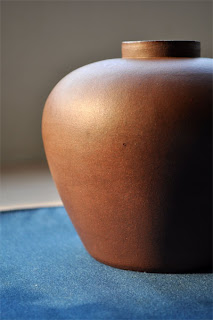 Baozhong tea started near Taipei, in Nangang, but progressively moved south east of Taipei, towards Pinglin, in search of a natural environment, away from the growing capital. Here, in the Wenshan area, the farmers have found a very well preserved region with beautiful landscapes.
Baozhong tea started near Taipei, in Nangang, but progressively moved south east of Taipei, towards Pinglin, in search of a natural environment, away from the growing capital. Here, in the Wenshan area, the farmers have found a very well preserved region with beautiful landscapes. 
 In the 19th century, Baozhong (Pouchong) and flower scented Baozhong were mostly exported to South East Asia by Taiwanese dealers. Western dealers like TAIT (see Kirsten Kristensen's picture of an old TAIT & Cie tea label) would use the name 'Formosa Oolong', even though they were exporting the same tea!
In the 19th century, Baozhong (Pouchong) and flower scented Baozhong were mostly exported to South East Asia by Taiwanese dealers. Western dealers like TAIT (see Kirsten Kristensen's picture of an old TAIT & Cie tea label) would use the name 'Formosa Oolong', even though they were exporting the same tea!
The name 'Oolong' stands for all semi-oxidized teas. But in Taiwan, nowadays, the name 'Oolong' is mostly used to designate the rolled Oolongs while Baozhong is used for the twisted, unroasted, low oxidized leaves. Baozhong can be made with all kinds of cultivars, but the most traditional remains qingxin (luanze) Oolong.
 The traditional technique, the weather and the environment all contribute to make Wenshan Baozhong distinctive from rolled Oolongs made elsewhere in Taiwan.
The traditional technique, the weather and the environment all contribute to make Wenshan Baozhong distinctive from rolled Oolongs made elsewhere in Taiwan. Below, a quick competition tasting (3 gr / 6 minutes) of the 4 spring 2010 Wenshan Baozhongs I selected:
Below, a quick competition tasting (3 gr / 6 minutes) of the 4 spring 2010 Wenshan Baozhongs I selected:
 'Flower' Baozhong.
'Flower' Baozhong. Hand harvested on April 17.
Luanze Oolong cultivar.
Light oxidation.
Flowery fragrance mixed with some sea scents reminiscent of Japenese sencha. Very soft and sweet taste, and lingering aftertaste.
I could also mention freshness, but I would have to do so for all 4 Baozhongs!
Hand harvested on April 7.
Luanze Oolong cultivar.
Low to medium oxidation, without stems and very lightly roasted.
This is the more traditional version of Wenshan Baozhong. It lets you best smell and taste the aromas of the mountainous forest where these leaves come from. This tea is fine and mellow with a slight astringency that transforms into sweetness as it lingers on and on. The fragrances are a little bit more fruity and 'foresty'.
Hand harvested on April 17.
Luanze Oolong cultivar.
Low oxidation. Stems are kept on purpose.
Intoxicating dry fragrance (hints of lavender). Modern way of processing Baozhong. Very light and 'green' spring fragrances. The taste is clean, soft with a touch of 'lemon'.
Hand harvested on April 17.
Luanze Oolong cultivar.
Light to medium oxidation.
These leaves have been harvested young (lots of buds) and have a light green color once brewed. The fragrance is light fruity (mango). The taste is pure and delicate.










































